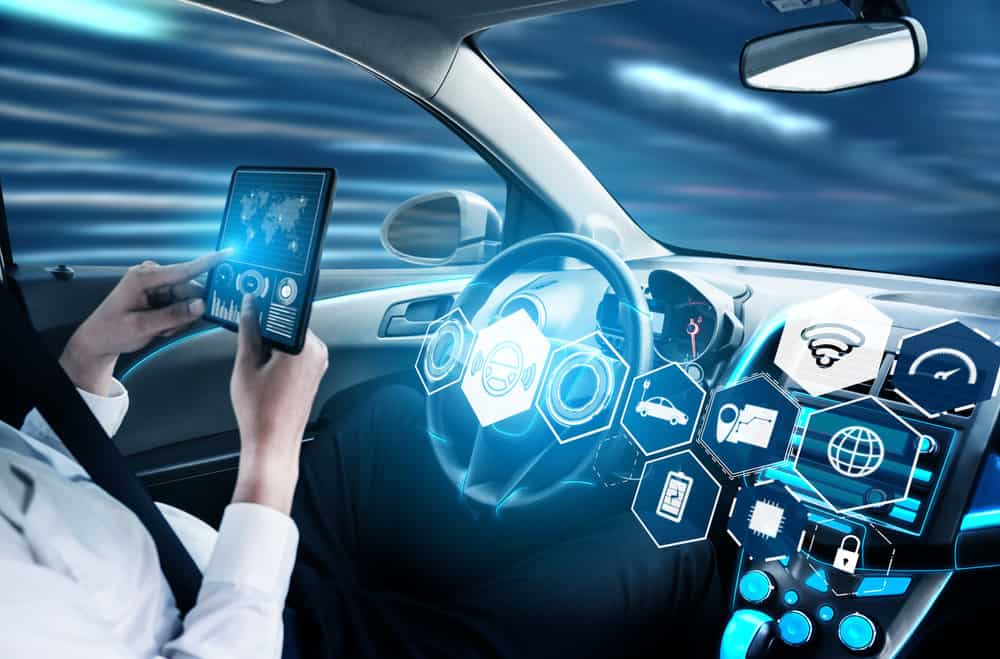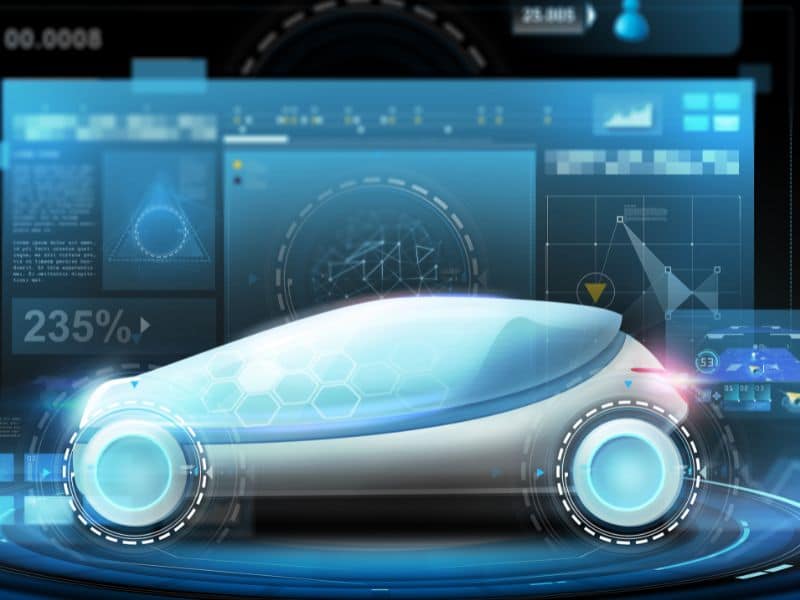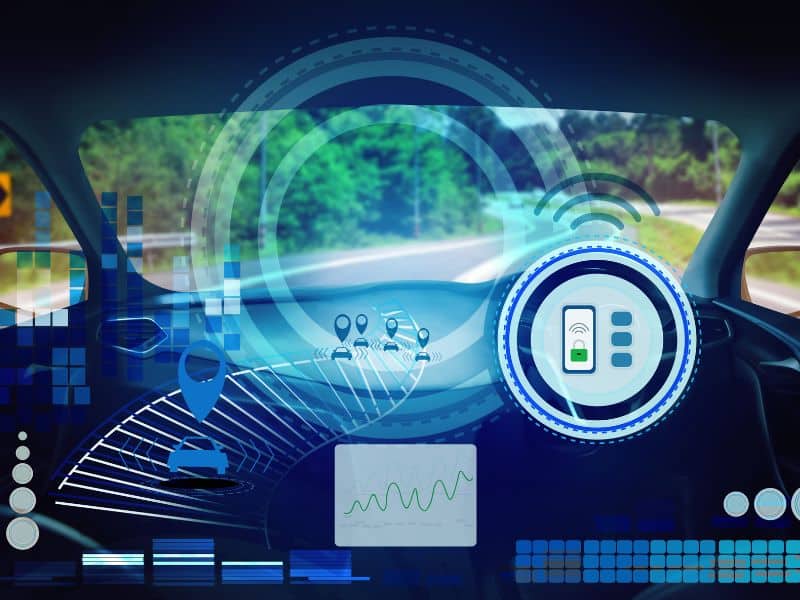Smart cars, also known as connected cars, are vehicles linked to external networks, often through features like Bluetooth, GPS, or an embedded SIM card for internet connectivity. The term typically refers to cars with a dedicated internet connection, providing constant connectivity. This facilitates remote communication through smartphone apps.
Despite being present on roads for a long time, manufacturers continuously aim to improve this technology further. Buying a smart car comes with benefits like navigation, entertainment, safety, and efficiency, but they also raise concerns regarding security, privacy, and ethics, as revealed by ExpressVPN.
How do connected vehicles function?
Smart cars rely on two networks to function—internal and external. The internal network, akin to your home’s local network, links car components through systems like Controller Area Network (CAN), FlexRay, or ethernet, facilitating data sharing for functions like brake control.
The external network connects the vehicle to other cars, your phone, or home Wi-Fi. These networks allow smart cars to communicate with the manufacturer and the outer world, mirroring the dual networks in your home, where devices talk to the internet and each other seamlessly.
Smart cars employ diverse communication technologies: cellular network for connectivity and in-vehicle hotspots, Bluetooth for hands-free phone access, Dedicated Short-Range Communication (DSRC) tailored for connected vehicles, and Near Field Communication (NFC) for short-range wireless interactions, such as remotely starting engines or unlocking doors.
Smart cars function similarly to applications, collecting data through sensors on speed, fuel consumption, and more. Utilizing networks like cellular or satellite, the data is transmitted to manufacturers who analyze it for personalized benefits such as maintenance alerts, service scheduling, and customized routes based on driver habits.
How do smart cars connect?
Intelligent car connectivity focuses on three types:
Vehicle-to-vehicle (V2V) enables communication through 360-degree radio signals, exchanging information about nearby vehicles.
Vehicle-to-infrastructure (V2I) uses wireless networks for data exchange with road infrastructure, warning about road conditions.
Vehicle-to-Everything (V2X) involves vehicles collecting and transmitting data using DSRC or cellular V2X (C-V2X) LTE, connecting with other vehicles, pedestrians, and cyclists.
The Pros of Smart or Connected Cars
Your smart car could communicate with other vehicles on the road, monitor the environment and surrounding infrastructure, and update you with real-time information based on all the relevant data it picks up. That prospect would have significant upsides that would improve how we commute. Let’s explore how:
1. Traffic Forecast
In a future dominated by smart cars, vehicles can tap into real-time data from sensors, cameras, and smart city infrastructure to enhance traffic analysis. This data-driven approach enables cars to offer personalized route recommendations, minimizing congestion and reducing travel time.
Advanced navigation apps like Waze already employ similar strategies, utilizing satellite data and user input to dynamically adjust routes, bypass traffic jams, and adapt to changing road conditions. This intelligent use of information not only improves individual commute experiences but also contributes to a collective reduction in carbon footprint.
2. Emergency Support
A smart vehicle offers extensive information, yet unforeseen events persist. In such cases, your connected car utilizes telematics and infotainment for assistance. In accidents, it can call emergency services, notify nearby service centers for faults, or prompt vehicles to maintain distance.
If no help is nearby, your car guides you through a quick fix. Against intruders, it doesn’t just alarm but autonomously alerts authorities for aid. The vehicle goes beyond data, proactively ensuring safety in unexpected situations.
3. Over-the-air Updates
Car makers utilize over-the-air updates to address issues or enhance smart car performance, similar to updating software on your phone or laptop. This eliminates the necessity of physically returning your vehicle to the dealer for issue resolution, as fixes are implemented remotely.
This update method also alters the concept of recalls. Previously, manufacturers had to recall numerous vehicles for servicing even if the issue could be rectified through a software update.
4. Car Care
Cars currently notify you of common issues or when an oil change is needed, but an intelligent vehicle could autonomously gather and analyze data, offering a comprehensive health assessment. This proactive approach would alert you to potential problems before they escalate, allowing preemptive measures. Before a component failure, the car might adjust settings or provide maintenance advice to prevent undue wear and tear.
In routine upkeep, similar to your computer sporadically reporting system errors, these automobiles could transmit essential data to manufacturers regarding crucial matters, facilitating prompt resolution.
5. Effortless Parking
When cars achieve connectivity, they’ll smoothly transport you to your destination and proceed autonomously to locate a parking space. Current self-parking features enable a simple button press, letting you relax as the car handles parking. Yet, once they safely achieve autonomous driving, the complete experience will be available.
6. Upgraded Infotainment
Many contemporary vehicles aid drivers in basic tasks like answering calls, checking blind spots, or playing music. With Apple and Google partnering with most manufacturers, we witness a surge in advanced in-car voice assistants, enabling drivers to focus on the road while accomplishing a more comprehensive array of tasks.
Drivers can perform these actions hands-free, and automakers might expand available services on the infotainment system, capitalizing on the vehicle’s data transfer capabilities. Some cars already feature augmented reality, projecting graphics onto the windshield for navigation guidance and highlighting road users or obstacles, foreseeing a shift away from traditional in-car screens.
The Cons of Smart or Connected Cars
Privacy Nightmare
Smart cars heralded for convenience, bring a troubling caveat— a severe violation of privacy. These vehicles incessantly harvest an extensive array of personal data, from basic details to biometrics, shaping an intricate profile of users. Smart cars transmit this information to manufacturers and, often, third-party entities.
The scope is alarming, covering personal, location, digital, demographic, financial, and biometric aspects, even delving into intimate details like sexual activity and genetic information.
The data mining extends beyond the vehicle, exploring external sources for additional insights into income, immigration status, race, and more.
As smart cars evolve, questions arise about drivers’ control over their data and the need for ethical handling by companies. The prospect of automakers transforming into data miners raises concerns about privacy in a smart car-dominated future.
Mobile application protection weaknesses:
As the automotive industry embraces connectivity, mobile application security vulnerabilities pose a significant threat. A case in point is the Nissan Leaf, where security testers showcased unauthorized access to vital functions like the heated steering wheel and air conditioning, demonstrating the potential for battery drainage and immobilization. Alarmingly, Verizon Mobile Security Index 2023 reported that mobile malware attacks increased by 52% in 2022 compared to 2021.
Absence of “designed-in” safety:
The absence of “designed-in” security compounds the issue. The industry’s limited experience with cybersecurity risks is evident in the inadequate integration of security into software and hardware components of early connected cars. Insufficient education on secure coding practices and delayed security testing exacerbate the problem, emphasizing the need for a proactive approach to building “Secure by Design” systems from the outset.
Safety weaknesses in the complicated supply chain:
Complications also arise in the complex supply chain, where automotive manufacturers heavily depend on third-party vendors. Without stringent cybersecurity requirements imposed on Tier 1 and Tier 2 suppliers, security vulnerabilities may infiltrate the vehicle components, while counterfeit parts pose safety risks, compromising crucial functions like braking.
Lagging on security updates:
The failure to promptly implement security patches and updates leaves systems susceptible to emerging threats. The challenge lies in the secure and timely deployment of updates, often dependent on wireless communications and personal computing devices, presenting inherent security challenges.
In-Vehicle Infotainment (IVI) susceptibilities:
In-vehicle infotainment (IVI) weaknesses further heighten the risk landscape. While innovations in entertainment systems enhance driver experience, integrating services utilizing sensitive data introduces security-critical aspects.
Both Android and Apple offer infotainment systems with app stores, presenting opportunities for combining diverse applications. However, this convergence also opens avenues for app-centric malware attacks on automotive platforms, emphasizing the need for robust security measures in this evolving landscape.
How can you safeguard yourself in a smart car?
If, after reading the pros and cons, you are a little skeptical about owning a smart car, you shouldn’t be. Just as you safeguard your online presence, you can implement the following measures to ensure the security of yourself, your car, and your data.
- Explore alternatives:Different connected car platforms empower users to regulate data sharing with their car manufacturer or auto insurer.
- Secure data:Utilize a virtual private network (VPN) to encrypt online connections, rendering stolen data useless to cybercriminals.
- Personalize preferences:Adjust privacy settings on applications and smartphones, restricting shared information. For instance, disclose the location only during app use or block it entirely.
- Employ robust passwords:Opt for unique, strong passwords with a mix of uppercase and lowercase letters, numbers, and special characters for each application, ensuring a minimum length of 8-10 characters.
- Keep software up-to-date:Regularly update your smart car’s software, likemaintaining your computer’s operating system promptly with available updates.
- Examine privacy policies: Familiarize yourself with privacy policies to comprehend your rights, including data collection specifics and the option to opt out of third-party data sharing.


